CRM Job Report January 2023

Tracking CRM employment demand, wages & required education
Twin Cairns is Evolving!
As we move data gathering responsibilities to the Twin Cairns Intelligence Unit, we expand the depth and breadth of information collection. As our analytical capabilities expand, we are upgrading the way we report and display data – to make the data more granular and relevant. Beginning in this Jan 2023 Monthly Job Report, the following improvements will be implemented:
- Beginning with the Feb 2023 data, Monthly Job Reports will be published on the first day of the next month (Feb Job Report would be published on April 1). Having 30 days to process and analyze the data will allow us to better display and interpret trends in the industry.
- While we aggregate large data sets, breaking those data to regions by month provides for poor statistical analysis – the numbers per region are too small. To make the analysis more robust, we will aggregate and publish regional data by Quarter only. Such reports will be available for purchase for a nominal fee of $5.99. The first such report would be published on April 2023, analyzing data for the last six quarters.
- We now have two years’ worth of CRM job data. Once we reach the end of 2023, we will have sufficient data (three years’ worth) to provide annual analysis of trends in the sector, examining long term analysis. Such reports will be available for purchase for a nominal fee of $12.99.
- We added tracking and presentation of several new data points:
- Benefits: We are now tracking and publishing data about benefits offered. Initially, this will be a simple binary recording of benefits offered. By April 2023, our system will begin collecting and publishing granular data about the type of benefits offered for each job.
- Government vs. Private Sector Jobs: Government and the private sector operate differently, and it is therefore important to report employment data that differentiate between the two employer types. This begins with our Jan 2023 report.
- Position Duration: Many CRM jobs are offered as temporary positions only. We are now tracking the duration of employment by position type (Techs, Crew Chiefs, PM/PI’s) to gain a better understanding of career paths offered in CRM sector. This begins with our Jan 2023 report.
- Degree Requirements: We are now publishing degree requirements for each position type – Techs Crew Chiefs, PM/PI’s. Many are calling for increased ‘professionalization’ of the sector. Others are warning about ‘dumbing down’ the workforce to address acute labor shortages. Tracking degree requirements, together with field school requirement for Field Techs will allow the community to evaluate workforce quality and its changes. This begins with our Jan 2023 report.
- Website performance for Twin Cairns: We will now publish data about daily vies per day, as well as average views per job on the Twin Cairns site. These data provides Employers and Job Seekers a proxy to understand growth (or decline) in the CRM sector. We are, unfortunately, unable to conduct the same analysis for Shovelbums or archaeologyfieldwork.com as we do not have access to their servers. This begins with our Jan 2023 report.
More improvements will be added in the next few months, as we further grow our data gathering and analysis capabilities. We are proud to serve the CRM community and hope these data provide relevant insights and informed Job Seekers and Employers, as well as those concerned with policy, management and increased protection of our shared cultural heritage.
Twin Cairns Performance
The number of views of job posts on Twin Cairns fluctuates daily. General use, however, is increasing – from ca. 200 views/day recorded in mid July 2022 to ca. 425 views/day by January 2023 – a 113% increase (Fig 1).
On average, each job posted on Twin Cairns is viewed 2.2 times/day. That number is increasing as more users spend more time at the site (Fig 2). By the end of January 2023, each job was viewed, on average, 2.8 times/day – a 27% increase.

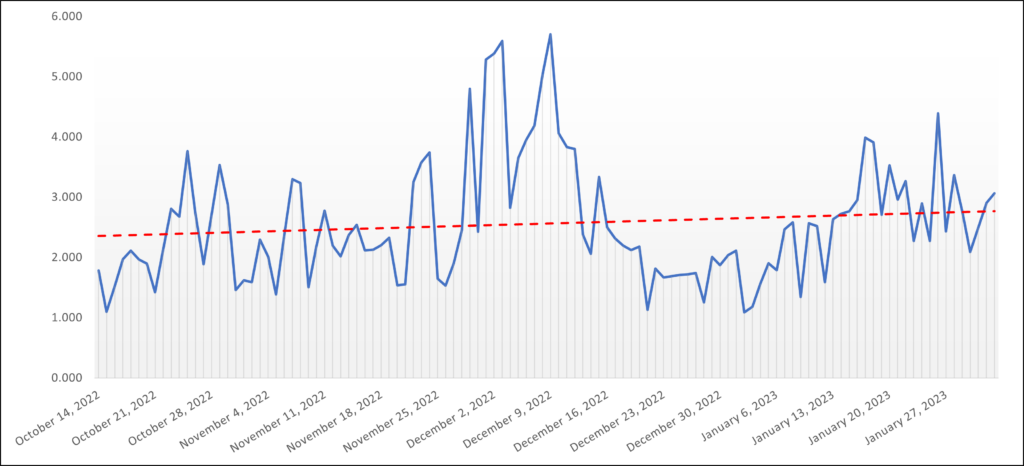
Number of Jobs Posted
The number of CRM jobs posted for Jan 2023 was uniquely high (Fig 3). The monthly average for a typical January is 37 posts for Shovelbums and 59 posts for archaeologyfieldwork.com. Job posts increased by an average of 75% across all job posting sites (Fig 4).
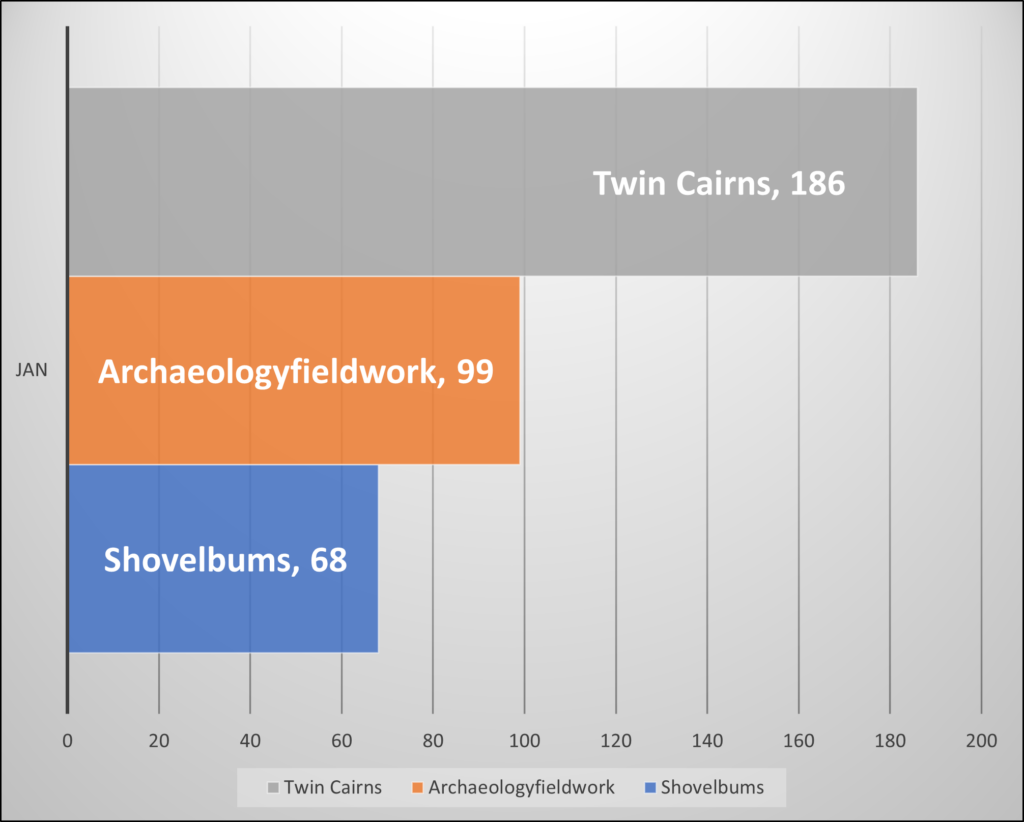
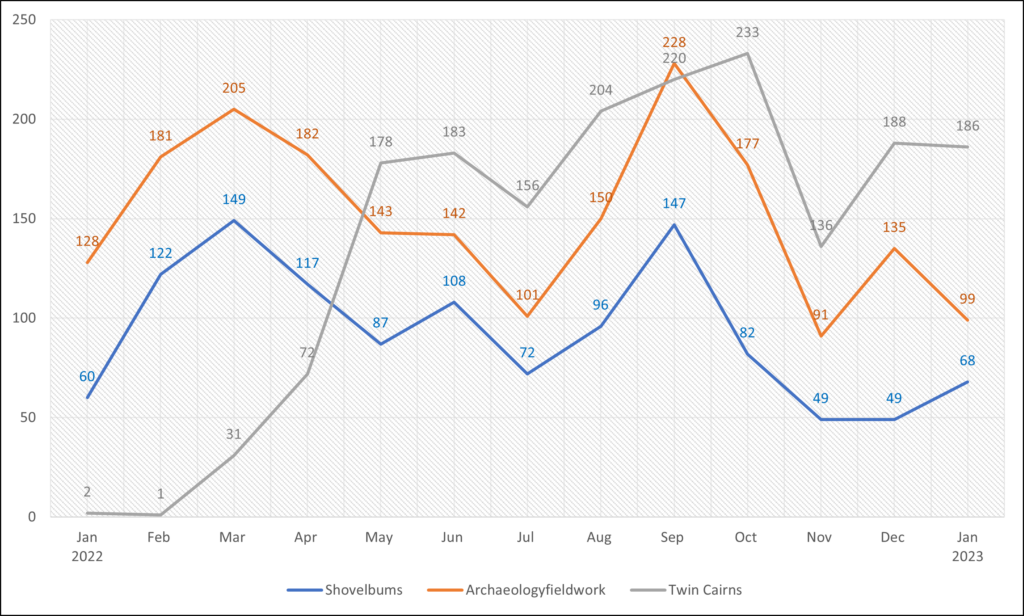
Jobs Posts by Region
Per usual for winter, most CRM jobs were offered in the warmer parts of the US: Southeast, Southwest and the West (Fig 5). Despite the harsh winter, many positions were published for the Midwest and Mid Atlantic, indicating both high demand and preparations for projects to begin in the spring.
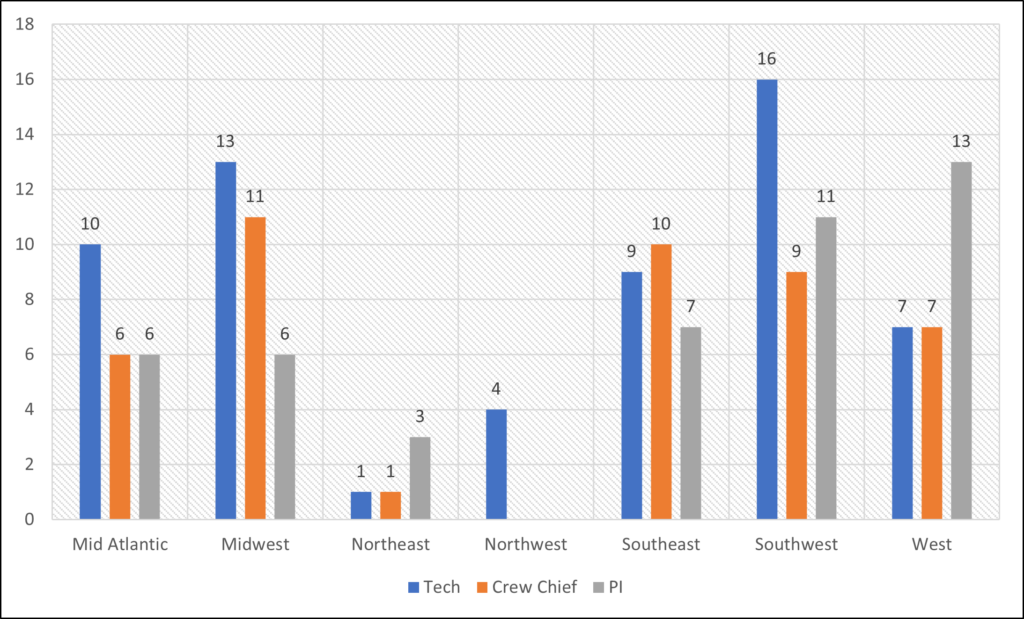
Employer Types
The private sector continues to dominate hiring, with 69% of all hires (Fig 6). Government hiring continues to be robust, especially at the federal level (Fig 7). Most of private sector hiring is done by CRM companies, with full environmental services companies coming a strong second.
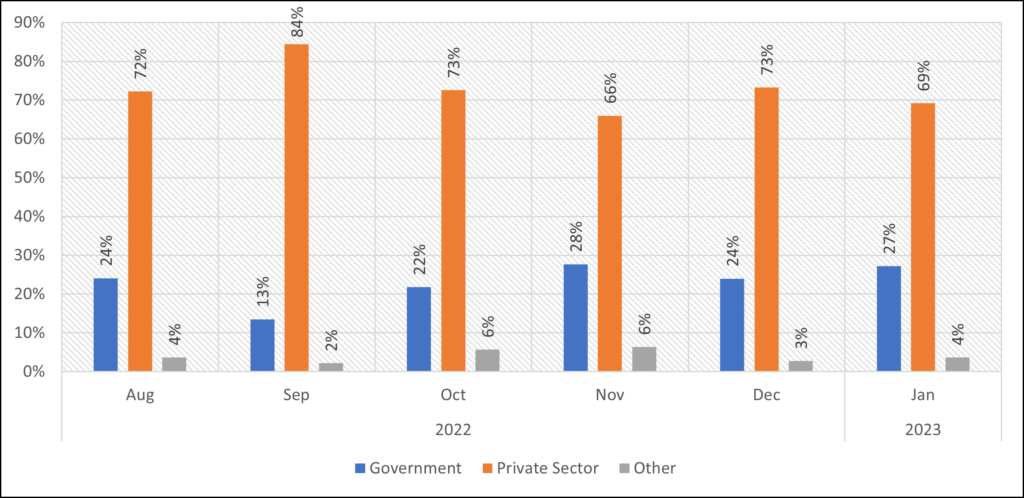
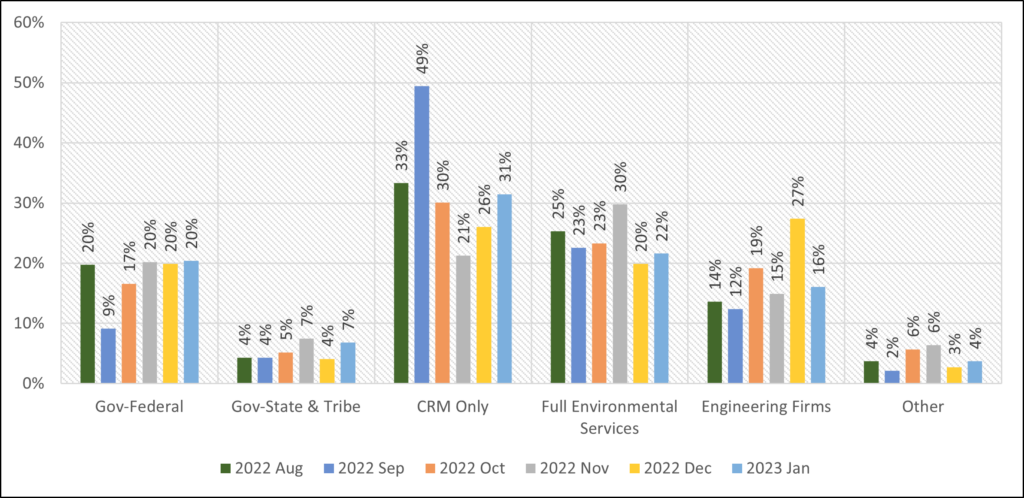
Position Duration
For Jan 2023 – when we started to track these data – most CRM positions were offered as permanent jobs (Fig 8). The distribution of permanent jobs, however, was not equal for all position types. Only 4% of Field Tech positions are permanent, while almost all Crew Chief and PM/PI jobs were offered as permanent positions (Fig 9).
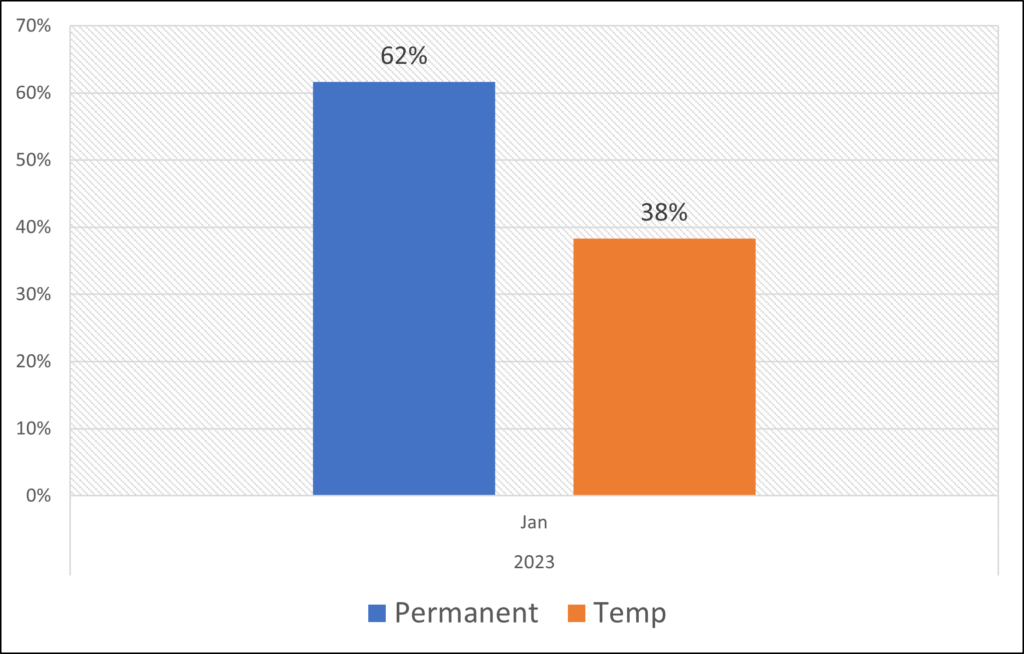
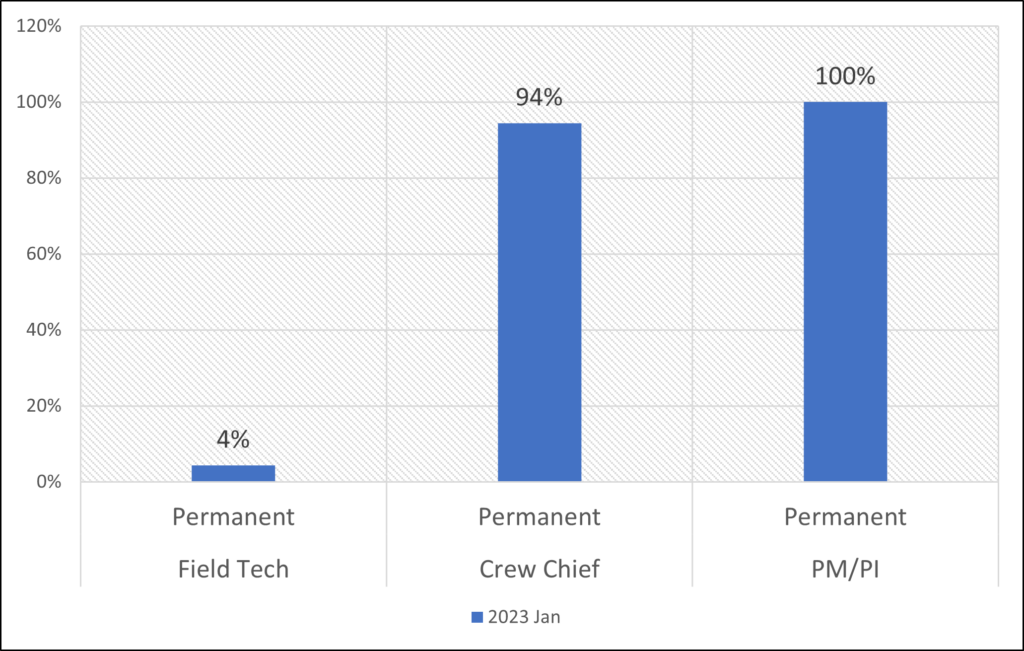
Wages
Nationwide, Field Tech wages rose by 7.2%, a healthy increase considering inflation (Fig 10). Crew Chief wages increased by 12%, compensating for a decline in December 2022. PM/PI wages decline in January by 2%, but overall, wages for PM/PI are sharply increasing, with some positions offering wages at the range of $150,000 per year.
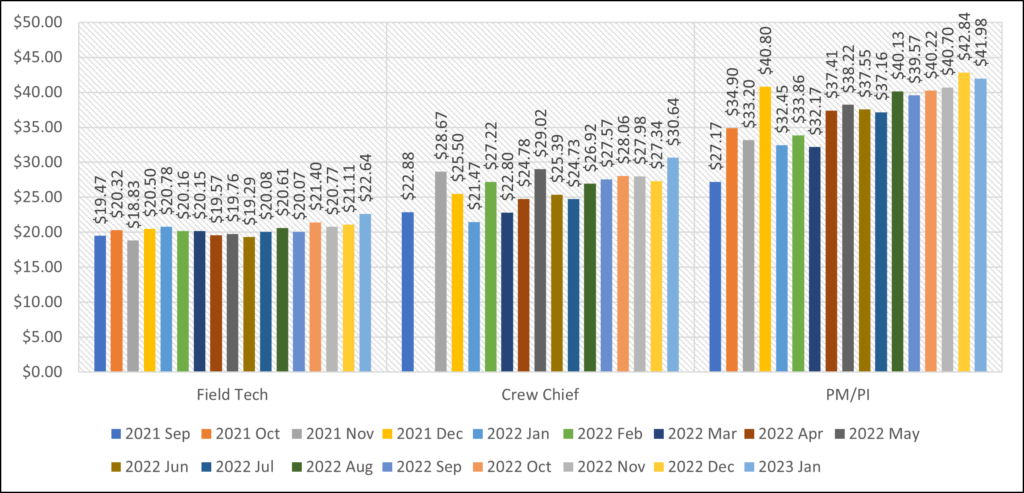
Government vs. Private Sector Wages
Government wages (federal, state & tribal) are usually higher than those paid by private sector employers. In the past 17 months, wages for all positions – on average – are increasing. For Field Techs, the wage gap is narrowing, with dramatic average private sector wage increases (Fig 11). For Crew Chiefs, the gap is narrowing even faster, despite government increasing wages for this position type (Fig 12). For PM/PI, however, the trend is reversed, and the gap is widening, as governments increase wages for these positions (Fig 13). Driving the competition from the private sector are engineering companies, paying top wages to increase Environmental Impact Reports so large-scale projects could be launched fast.
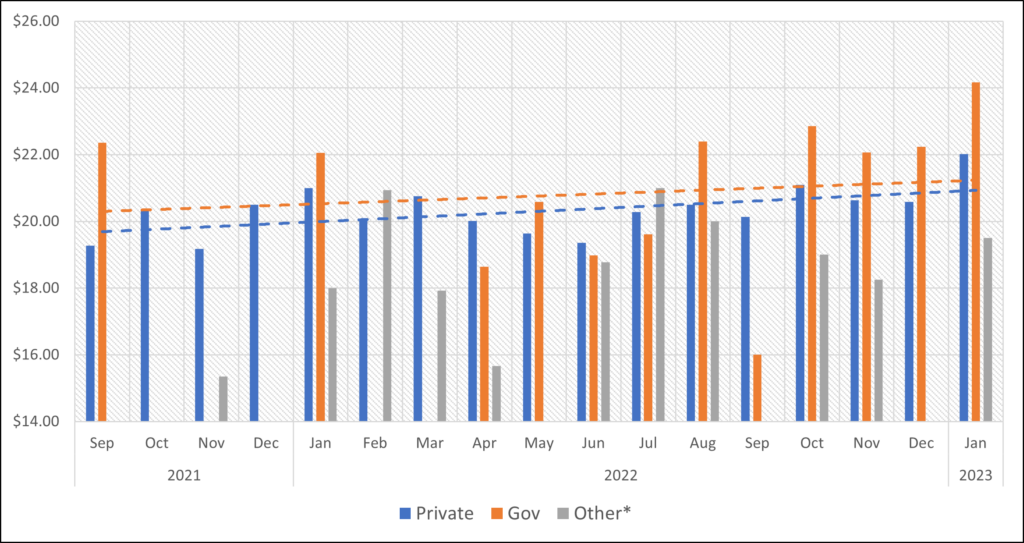
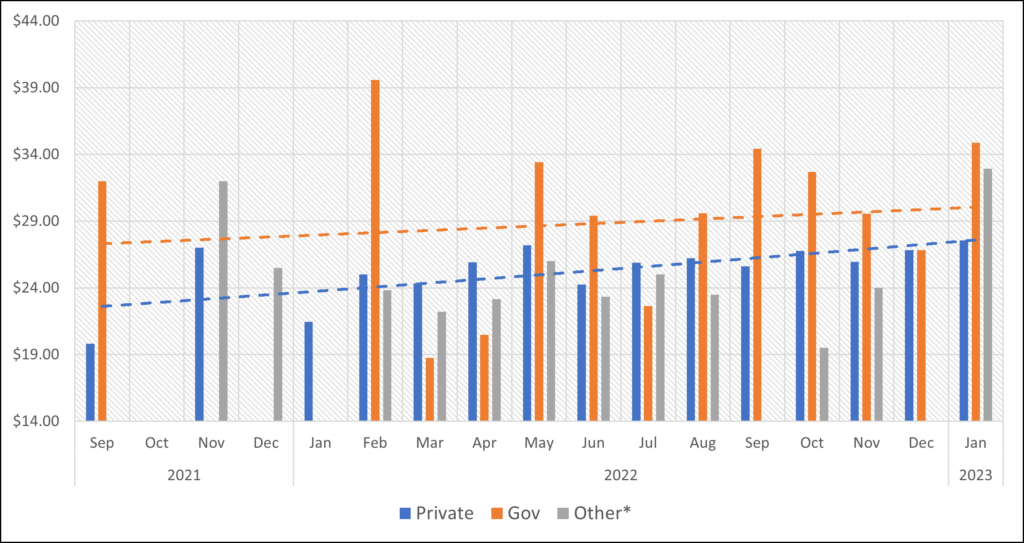
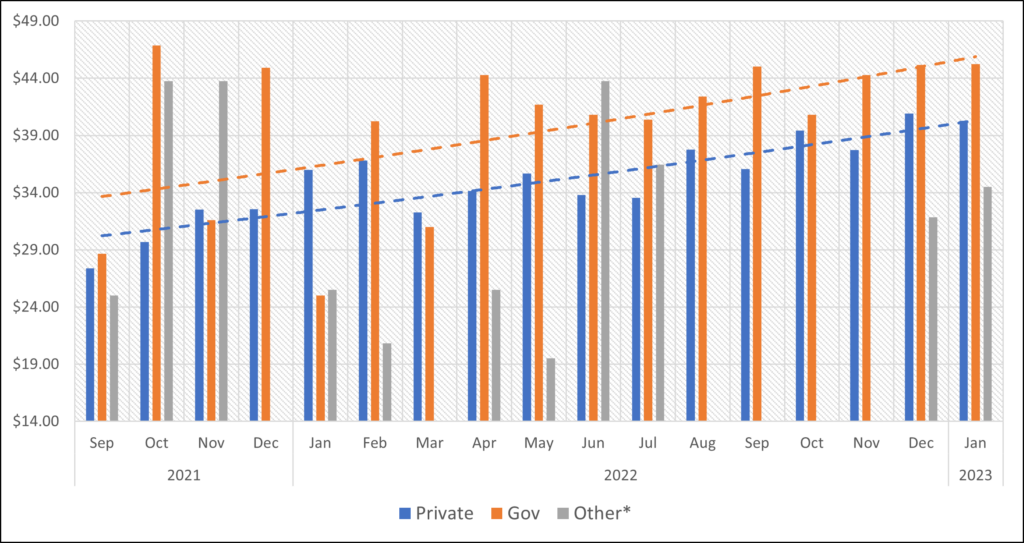
Published Wage Data
For most of 2022, the number of job postings that included wage information was increasing, reaching 92% rate for PM/PI in Aug 2022 (Fig 14). Since that peak, publishing wages decreased, despite wage transparency laws adopted in several states and the fact that jobs with wage data are viewed, on average, 30% more than job posts with no wage information.
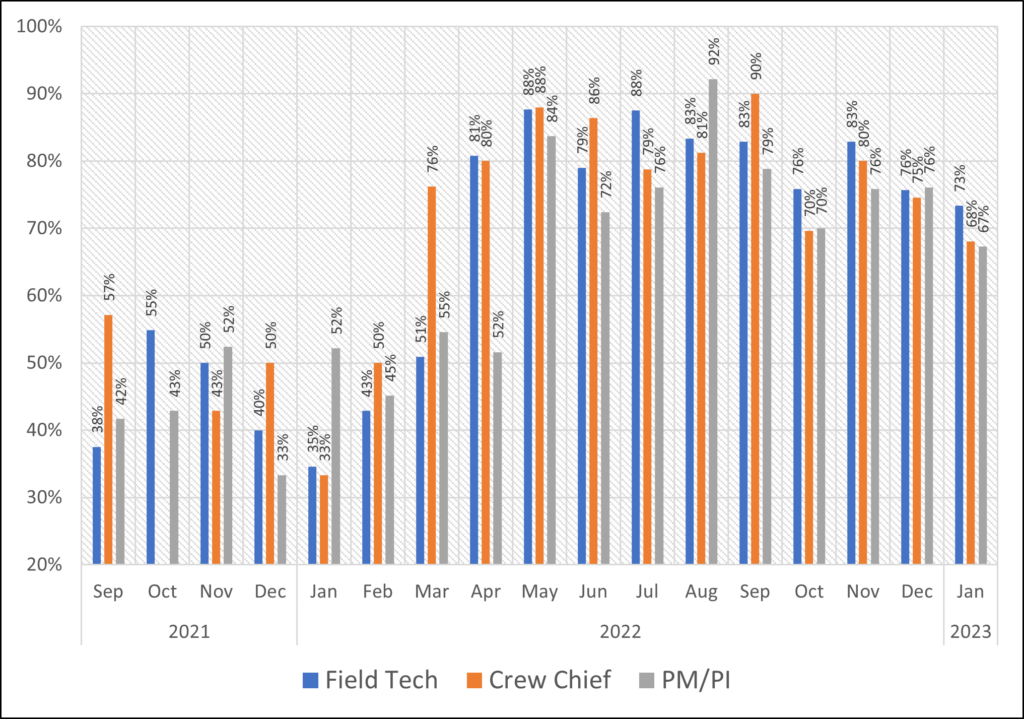
Wage Differentials
Wage differentials between Field Techs & Crew Chiefs, and between Field Techs & PM/PI’s is increasing (Fig 15). By December2022, PM/PI’s were earning x2 as much as Field Techs – an increase of 45% in pay differential since September 2021. Although that differential declined to x1.8 in January 2023, the wage differential gap is on an increasing trajectory. The same pattern is seen when comparing wage differential between Field Techs and Crew Chiefs, albeit with a much shallower increase curve.
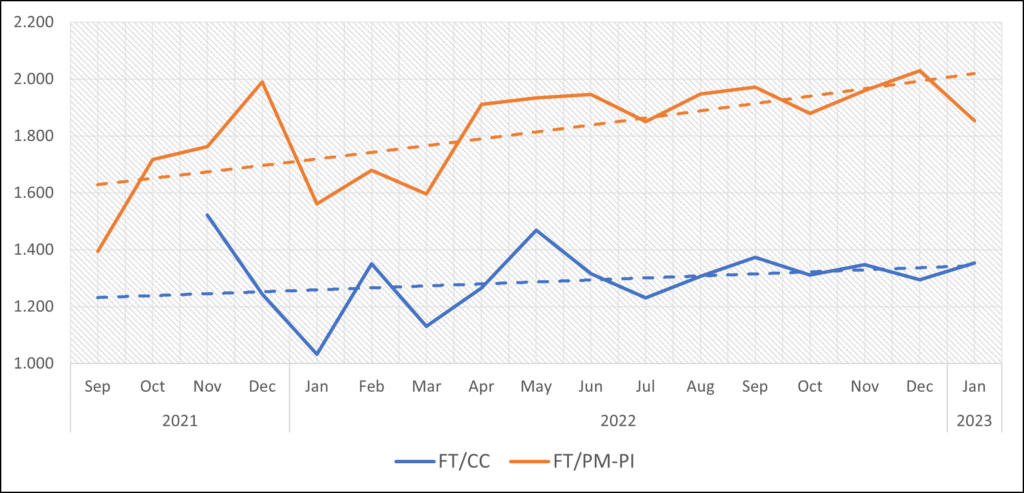
Benefits
Less than half of all Field Tech positions offered any benefits at all, while the vast majority of Crew Chief and PM/PI positions offered benefits (Fig 16). For January 2023, over two thirds of job posts for Field Techs for government agencies offered benefits, while only one third of private sector positions offered such perks (Fig 17).
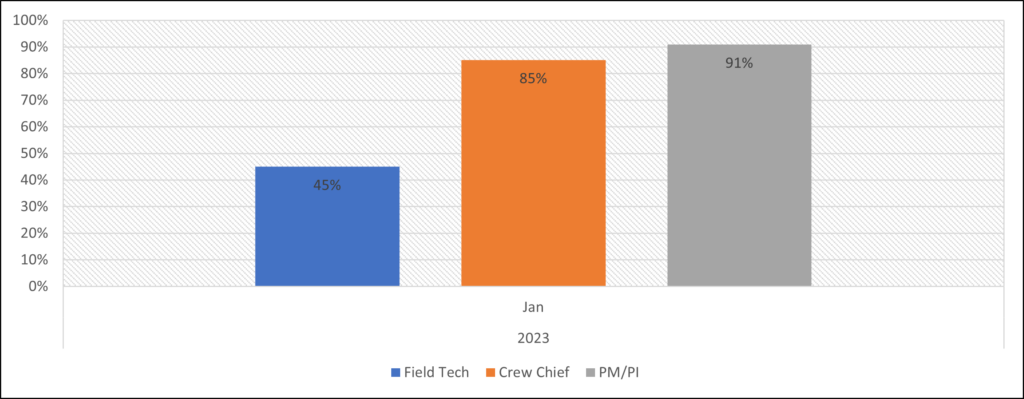
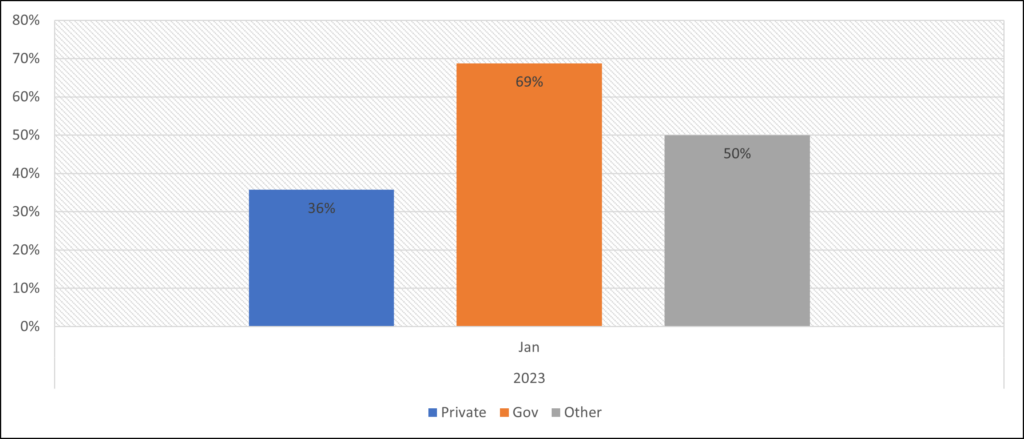
Education Requirements
Education requirements across the CRM sector seems to be increasing (Fig 18). Demand for professionals with graduate degree is increasing and demand for those with High School or Associate Degree diplomas is decreasing (Jan 2023 seem to be an outliner).
This pattern seems to be consistent at all position types. The demand for Field Techs with BA/BS degree is robust, but at the low end of the spectrum, demand for an Associate degree is gone (Fig 19). In its stead, some employers accept High School Diplomas for entry level positions, suggesting education quality degradation for some positions.
The trend for better education is clear with Crew Chiefs (Fig 20). Demand for Crew Chiefs with graduate degrees in increasing in quite a dramatic way. For PM/PI, the demand for employees with graduate degree is stable (Fig 21), despite monthly fluctuations. Very few jobs require a PhD degree.
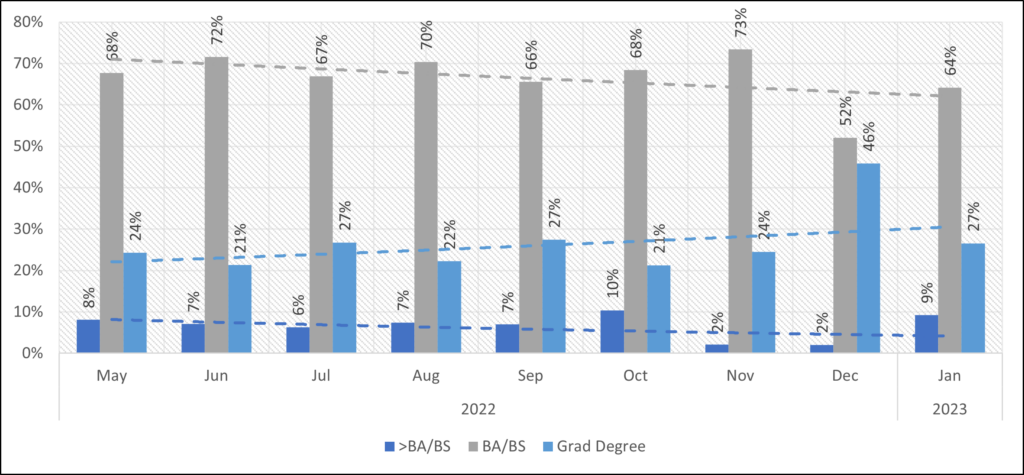
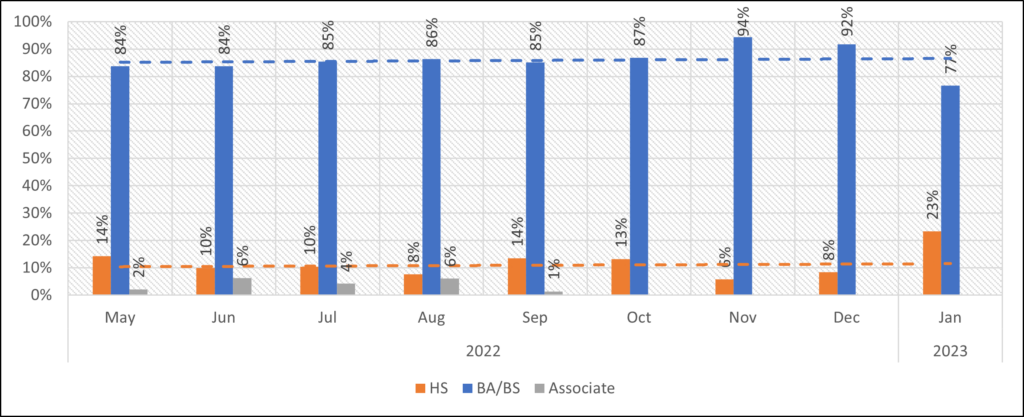
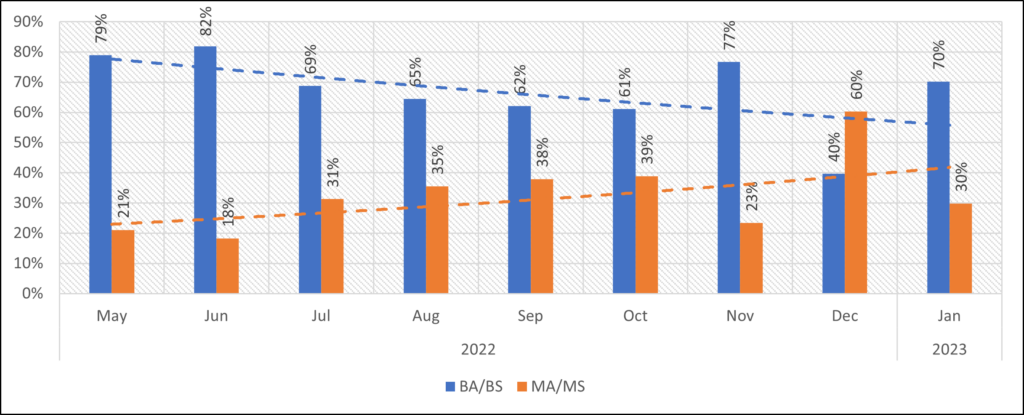
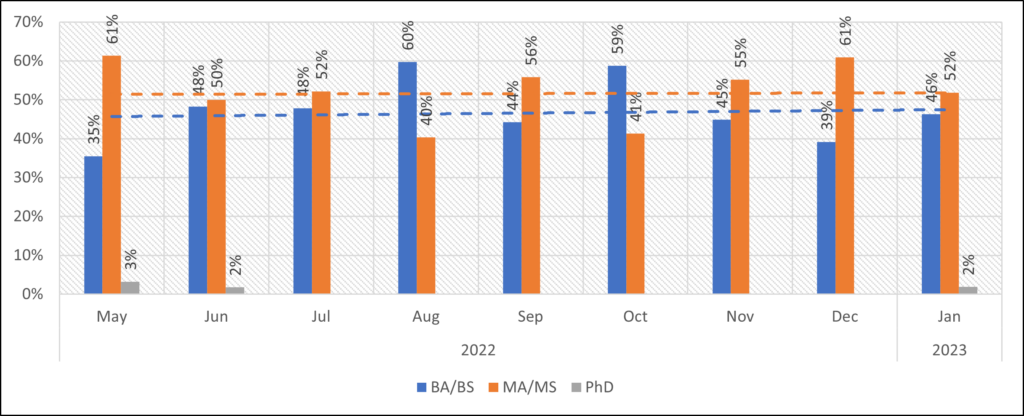
Training Requirement (Field School) for Field Techs
For the latter part of 2022, the requirement for field school experience for Field Techs was increasing. That requirement was reduced dramatically for Jan 2023 (Fig 22). It is too early to speculate whether January was an anomaly or a beginning of a trend. We will continue to track this requirement and present data in future Monthly Job Reports.
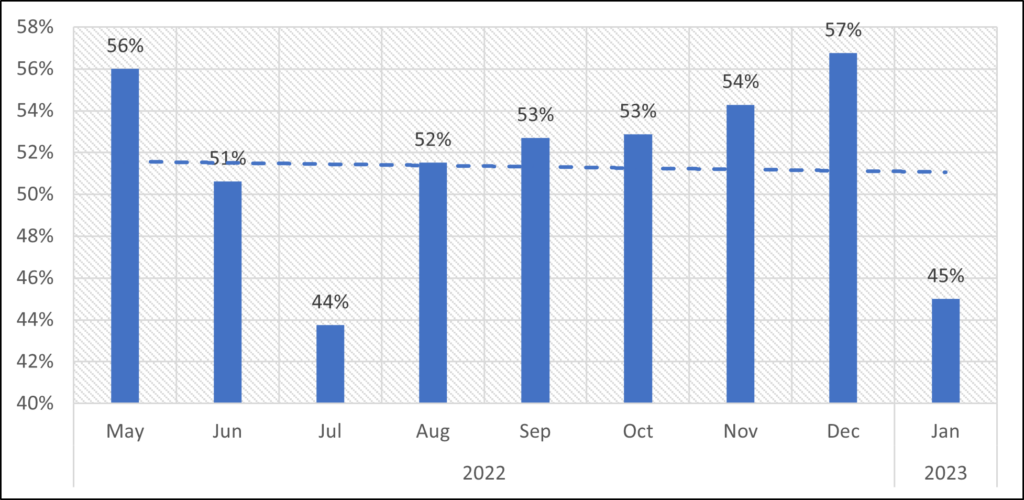
Better data, better decisions, better employment & employees


